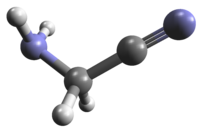|
The present entry is based on a combined fit of
rotational data in the ground and first three excited
vibrational states along with FIR data pertaining to
the three lowest vibrational bands. The data set
concerning the v17 = 1 rotational
transition frequencies is identical to that of the
first entry of Aug. 2017.
The state v17 = 1 is the third lowest
vibrational state of aminoacetonitrile. The rotational
transition frequencies were reported by
(1) C. Degli Esposti, L. Dore, M. Melosso, K. Kobayashi,
C. Fujita, and H. Ozeki,
2017, Astrophys. J. Suppl. Ser., 230, Art. No. 26.
The rovibrational transition frequencies were reported
by
(2) M. Melosso, A. Belloche, M.-A. Martin-Drumel, O. Pirali,
F. Tamassia, L. Bizzocchi, R. T. Garrod, H. S. P. Müller,
K. M. Menten, L. Dore and, C. Puzzarini,
2020, Astron. Astrophys., 641, Art. No. A160.
Extensive ground state rotational data were published
by
(3) Y. Motoki, Y. Tsunoda, H. Ozeki, and K. Kobayashi,
2013, Astrophys. J. Suppl. Ser., 209, Art. No. 23.
Additional transition frequencies were taken
from
(4) J. N. MacDonald and J. K. Tyler,
1972, J. Chem. Soc. Chem. Comm., 995;
(5) H. M. Pickett
1973, J. Mol. Spectrosc., 46, 335;
(6) M. Bogey, H. Dubus, and J.-C. Guillemin,
1990, J. Mol. Spectrosc., 143, 180;
and from
(7) R. D. Brown, P. D. Godfrey, A. L. Ottrey and J. W. V. Storey,
1977, J. Mol. Spectrosc., 68, 359.
The spectroscopic parameters employed here differ from
those in (2).
The calculations should be good enough for all
astronomical observations, those with uncertainties
exceeding 0.2 MHz should be viewed with caution.
State number 3 corresponds to
v17 = 1.
Please note that the partition function
currently considers only the ground vibrational state.
Vibrational factors for a posteriori correction will be provided.
The dipole moment components were assumed to be the same
as in the ground vibrational state, see e056507.cat.
|
